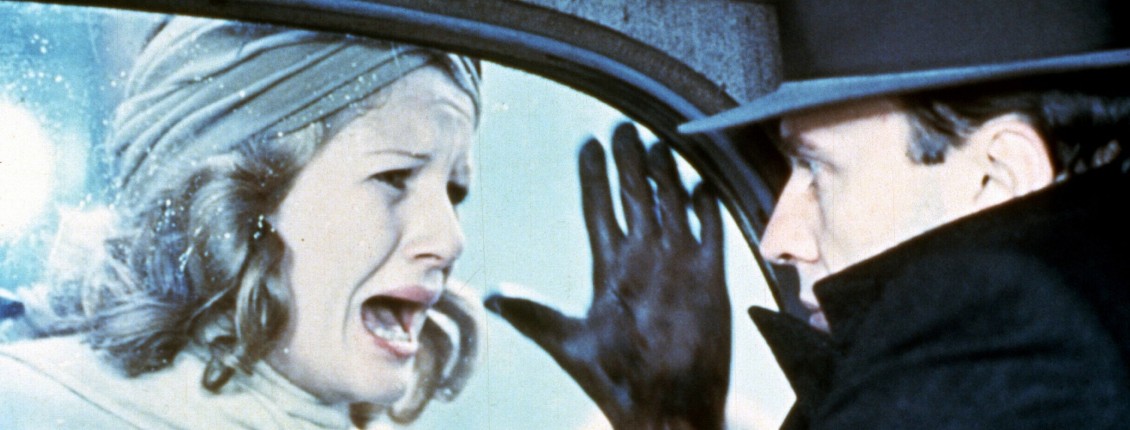We generally think of chance or random selection, in opposition to composition, certainly in opposition to mise-en-scène; but there are moments and circumstances that bring these very different conditions into dynamic interplay. I had occasion to consider this unpredictable and eccentric interplay in revisiting some of the museum and gallery shows I took in over the last year in Los Angeles.
Composition tends to be given less consideration, certainly less importance, in recent contemporary art (though, ironically, mise-en-scène occasionally figures prominently in varieties of performance and installation art). But I occasionally wonder if this is simply because we’re substituting another more schematic sort of composition in its place—a shape, set of conditions, elements arranged by a more or less methodical process.
We don’t even think of mise-en-scène in quite the same way with respect to the cinema. I had occasion to think about this issue more specifically in the days following a press preview for the future Academy of Motion Picture Arts & Sciences Museum’s curatorial programming; which was itself only a few days following the death of Bernardo Bertolucci. Inevitably the tributes flowed in, but a bit haltingly as the days went by—as if film critics and editors and the obituary writers weren’t quite sure what to make of a career that, however self-consciously modeled after a kind of Euro-auteur conception of the film director, seemed to lack stylistic consistency; that peaked in oddly conventional Hollywood-spectacle form; and that seemed to fade almost impotently in later films. To say nothing of #MeToo speculation. (I see no reason to speculate about Maria Schneider’s direction—or manipulation—in Last Tango; though as I recall, Stealing Beauty practically made my eyes roll back into my head.)
That Bernardo Bertolucci was a great cinematic storyteller seems indisputable. As to whether we should draw some distinction between his status as a truly great director or filmmaker or simply a great stylist and cinematic dramatist, seems trivial in the aftermath of his death. That he made great films, which were the cumulative product of his directorial decisions, should be sufficient criteria to judge his work as a director.
Yet there’s no denying his luck. Whatever else he was, Bertolucci was probably one of the luckiest filmmakers in history—beginning and ending with his career-long “marriage” with cinematographer Vittorio Storaro. It was as if Storaro had taken dictation from Bertolucci and his sources composed directly from storyboards. But Bertolucci was also clearly one of the most knowledgeable. His grasp of the history of cinema was encyclopedic; and however he may have occasionally mimicked peers or predecessors, he took ideas and inspirations from every kind of filmmaker and period of filmmaking. It’s the key to his supple approach to story adaptation. The script or source material was simply the template to facilitate the film he wanted to make.
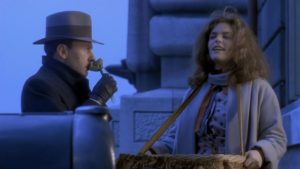 Ambiguity is the keynote to Bertolucci’s films, whether masterly or mediocre—not to be mistaken for ambivalence. He knew how to make a screen story work and the deliberate ambiguity feeds the mise-en-scène powerfully (and vice-versa). There is almost never a single ‘tone’ to a Bertolucci film; he tended to work with rich, complex palettes, muted or amplified (as Storaro might see fit) with filters. It’s one of the reasons he can steal from every kind of cinema imaginable—from 1930s ‘white telephone’ films (even while nodding to neorealism and French nouvelle vague—Godard in particular—and planting jokes about it within the same films), to classic Hollywood movies, film noir, the German expressionist style of UFA directors, and contemporaneous English and American films. He accesses every tool, technique, style to fill the screen with the light, scenery and movement that move the story forward—that propel the characters to their fates.
Ambiguity is the keynote to Bertolucci’s films, whether masterly or mediocre—not to be mistaken for ambivalence. He knew how to make a screen story work and the deliberate ambiguity feeds the mise-en-scène powerfully (and vice-versa). There is almost never a single ‘tone’ to a Bertolucci film; he tended to work with rich, complex palettes, muted or amplified (as Storaro might see fit) with filters. It’s one of the reasons he can steal from every kind of cinema imaginable—from 1930s ‘white telephone’ films (even while nodding to neorealism and French nouvelle vague—Godard in particular—and planting jokes about it within the same films), to classic Hollywood movies, film noir, the German expressionist style of UFA directors, and contemporaneous English and American films. He accesses every tool, technique, style to fill the screen with the light, scenery and movement that move the story forward—that propel the characters to their fates.
Ebb and flow is another characteristic of Bertolucci’s style. He’s fond of drifting forward and back; and so it was most critically, in the wake of Prima della Revoluzione, in his film of Il Conformista (The Conformist) Alberto Moravia’s clinical post-mortem of the nightmare that unfolded between that ‘white telephone’ era and post-war neorealism. Bertolucci deliberately altered Moravia’s black-and-white (in every sense) novel to deepen and amplify his color film. The straight-line trajectory (which is never exactly a ‘straight line’, even in the book) of the protagonist, Marcello—his conflict with his father, his mother’s decline, his nascent cruelty, fear and sexual confusion, his violation (actual and rationalized), and determination to purge the past and submerge his conflicted identity beneath a notional ‘normalcy’ within the constraints of a fascist order—in Bertolucci’s film is re-composed between actuality and sustained flash-back sequences into a kind of respiration and reclamation of past and present. The ‘present’ screen actuality is always driven by the only partially suppressed memory of the past.
Even the ‘present’ can seem ambiguous—a nightmare miasma or a dream-like, artfully shadowed or amber daylight (Bertolucci and Storaro make exquisite use of color filters in the film). A car rolls forward into a driveway knee-deep in autumn leaves as the camera crane arcs upward to take in the waves of wind-tossed leaves rolling backwards towards the actors, giving way briefly to the longer shot of the leafy street in which a youthful Marcello ambles awkwardly towards us, dodging the taunts of his classmates and shadowed by a car which may be his or….
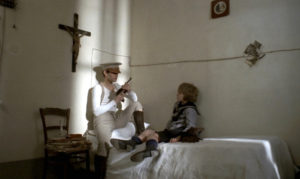 There’s ambiguity every step of the way—and Bertolucci even spells it out in the furtive, frightened, alternately vulnerable and threatening seduction of Marcello by Lino, the car’s chauffeur. (Pierre Clementi’s performance is an opera in miniature—almost literally—as only an actor like Clementi could deliver.) But we even see it in those classic EUR-type fascist vistas, which in Betolucci’s and Storaro’s hands become a De Chirico-esqe play of careering perspectives. (E.g., Marcello heading down a government building gallery or foyer through the matrix of light and shadow made by its windows, at a 30 degree angle to another figure heading toward the foreground; the government official brazenly indulging a sexual dalliance (presumably on government time) in a basilica-scaled executive suite, as Marcello reports to pick up instructions; the monumental, yet papier-mâché weight ornaments of fascist authority surreally juggled.)
There’s ambiguity every step of the way—and Bertolucci even spells it out in the furtive, frightened, alternately vulnerable and threatening seduction of Marcello by Lino, the car’s chauffeur. (Pierre Clementi’s performance is an opera in miniature—almost literally—as only an actor like Clementi could deliver.) But we even see it in those classic EUR-type fascist vistas, which in Betolucci’s and Storaro’s hands become a De Chirico-esqe play of careering perspectives. (E.g., Marcello heading down a government building gallery or foyer through the matrix of light and shadow made by its windows, at a 30 degree angle to another figure heading toward the foreground; the government official brazenly indulging a sexual dalliance (presumably on government time) in a basilica-scaled executive suite, as Marcello reports to pick up instructions; the monumental, yet papier-mâché weight ornaments of fascist authority surreally juggled.)
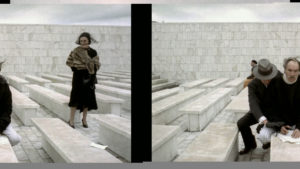 Bertolucci makes less ambiguous use of the EUR-type settings in the travertine visiting room where Marcello visits his father, which seems to take on the dimension of an amphitheatre, as if to demand a purgative confrontation—another distinct departure from the novel. It makes for a kind of cleavage in the material, though Bertolucci doesn’t let the viewer dwell too long on it, moving us relentlessly forward in step with Marcello himself, for whom examining any aspect of his past or himself would be insupportable. Here it is as much his forsaking of the opportunity to confront himself, to take measure of past and present, as well as his father and that (violent) legacy, that propels him toward his absurd fate—and fascism. It’s as if Marcello’s fascism is made the crux of the scene. Marcello’s father rejects not simply his own guilt and shame, but his son’s cypher-like evasion—an Oedipal abdication. His fascist declarations are simply the coup de grace, prompting him to call for his strait-jacket. Against that nihilistic prospect, he resigns himself to madness.
Bertolucci makes less ambiguous use of the EUR-type settings in the travertine visiting room where Marcello visits his father, which seems to take on the dimension of an amphitheatre, as if to demand a purgative confrontation—another distinct departure from the novel. It makes for a kind of cleavage in the material, though Bertolucci doesn’t let the viewer dwell too long on it, moving us relentlessly forward in step with Marcello himself, for whom examining any aspect of his past or himself would be insupportable. Here it is as much his forsaking of the opportunity to confront himself, to take measure of past and present, as well as his father and that (violent) legacy, that propels him toward his absurd fate—and fascism. It’s as if Marcello’s fascism is made the crux of the scene. Marcello’s father rejects not simply his own guilt and shame, but his son’s cypher-like evasion—an Oedipal abdication. His fascist declarations are simply the coup de grace, prompting him to call for his strait-jacket. Against that nihilistic prospect, he resigns himself to madness.
Much was made in the film’s initial reviews and later criticism of the film’s presumed linkage between Marcello’s repressed homosexuality and his fascism, his flight from self-identity and strait-jacketed pursuit of ‘normalcy.’ But this, too, is presented far more ambiguously than Bertolucci is given credit for.
 Marcello’s openly bisexual foil here is Anna (an incandescent performance by Dominique Sanda—feline, graceful, sensual, assured yet vulnerable, chic—altogether magnetic), who Bertolucci has perfected into a kind of idealized butch-femme woman, confident of who she is, what she wants—sexually, emotionally, intellectually—and how to get it, generously, sensitively, and above all beautifully. We see her size up Marcello right away, ready to pounce. There are no illusions here, even in the bourgeois comfort of her (and her husband, Marcello’s former Professor Quadri’s) Parisian refuge. Yet she accepts Marcello’s advances and reciprocates—up to a (sharp) point—even as she more provocatively indulges her fascination with Marcello’s wife, Giulia (a subtle, but characteristically graceful performance by the already legendary Stefania Sandrelli). It’s a blanket seduction—and a precisely calculated one. Yet we can believe that this Anna, disciplined dancer that she is, would go through it more or less the same way regardless of the stakes. The tango she dances in the restaurant pavilion with Giulia is as much Anna’s (and Bertolucci’s) homage to beauty, as a declaration of passion and desire. In the end, as the rest of the dancers twirl around the pavilion and spiral around Marcello, trapping him in the center, Bertolucci underscores his ensnarement, ensorcellment, and (self-)strait-jacketing.
Marcello’s openly bisexual foil here is Anna (an incandescent performance by Dominique Sanda—feline, graceful, sensual, assured yet vulnerable, chic—altogether magnetic), who Bertolucci has perfected into a kind of idealized butch-femme woman, confident of who she is, what she wants—sexually, emotionally, intellectually—and how to get it, generously, sensitively, and above all beautifully. We see her size up Marcello right away, ready to pounce. There are no illusions here, even in the bourgeois comfort of her (and her husband, Marcello’s former Professor Quadri’s) Parisian refuge. Yet she accepts Marcello’s advances and reciprocates—up to a (sharp) point—even as she more provocatively indulges her fascination with Marcello’s wife, Giulia (a subtle, but characteristically graceful performance by the already legendary Stefania Sandrelli). It’s a blanket seduction—and a precisely calculated one. Yet we can believe that this Anna, disciplined dancer that she is, would go through it more or less the same way regardless of the stakes. The tango she dances in the restaurant pavilion with Giulia is as much Anna’s (and Bertolucci’s) homage to beauty, as a declaration of passion and desire. In the end, as the rest of the dancers twirl around the pavilion and spiral around Marcello, trapping him in the center, Bertolucci underscores his ensnarement, ensorcellment, and (self-)strait-jacketing.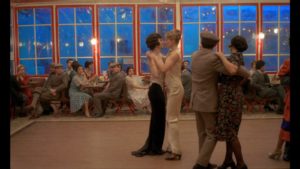
Even beneath the ridiculously hetero-normative commentary of his fascist compatriot, the blind broadcast announcer, Italo (Enzo Taraschio), the rapport he shares with Marcello suggests very different affinities. The viewer contrasts this with his relationship with his fellow operative, driver and advance man, Manganiello (Gastone Moschin), who, suspicious from the onset, can scarcely disguise his loathing and eventual disgust at Marcello’s cowardice and its presumed foundations.
We don’t even need to wait to the end to know that, as vacuous as she makes herself out to be, even Giulia knows the truth about Marcello. But the viewer also understands that she knows herself. She’s unguarded and susceptible; also, unlike her husband, at home in her body and sensibility. In the space of these small screen moments, we understand that Marcello has unknowingly betrayed even the ‘normalcy’ he sought.
The climax of the betrayal (the reversal of that dancehall tango) is his mute confrontation with Anna as she screams—in one instant for help, in the next for her life—horrified less by the prospect of her murder than the monster that confronts her from behind the closed passenger window. The confrontation lasts only a moment, after which Marcello merely gazes impassively towards the front of the car. It may be one of the most horrifying moments in the history of film narrative, followed by a passage of terror frozen in beauty.
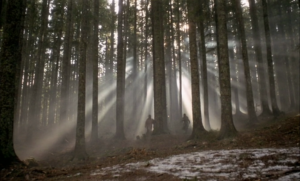 Shot entirely on location, the scene opens up like an alpine or arboreal combustion. The forest beyond the road is enshrouded in fog; and Manganiello’s and Clerici’s dagger-bearing fellow assassins emerge from behind the trees like whirling ghosts materializing from concealed caldrons, turning Quadri one way, then another, as they each stab him in turn. Strikingly elegant even as she’s running for her life, Anna heads into the forest, seeking cover in the same trees, but really just stealing time, as gunmen begin firing after her, and inevitably strike their target. A second shot strikes her and we see her stumbling forward, still turbanned, her face covered with blood, before a third shot brings her body to the ground.
Shot entirely on location, the scene opens up like an alpine or arboreal combustion. The forest beyond the road is enshrouded in fog; and Manganiello’s and Clerici’s dagger-bearing fellow assassins emerge from behind the trees like whirling ghosts materializing from concealed caldrons, turning Quadri one way, then another, as they each stab him in turn. Strikingly elegant even as she’s running for her life, Anna heads into the forest, seeking cover in the same trees, but really just stealing time, as gunmen begin firing after her, and inevitably strike their target. A second shot strikes her and we see her stumbling forward, still turbanned, her face covered with blood, before a third shot brings her body to the ground.
 But Marcello, stone-cold and vacant in his car, is himself a trapped animal here, chained prisoner of a quasi-‘Platonic cave’ situation akin to the one he and Quadri reminisced about only days earlier, except he’s as blind to the ‘shadows’ as he is to the light.
But Marcello, stone-cold and vacant in his car, is himself a trapped animal here, chained prisoner of a quasi-‘Platonic cave’ situation akin to the one he and Quadri reminisced about only days earlier, except he’s as blind to the ‘shadows’ as he is to the light.
I’m not sure if filters were used in this passage—the icy blues that dominate the scene could be completely natural and atmospheric. But Bertolucci and Storaro clearly used filters or dramatically altered the lighting in a number of passages: amber and gold in flashback passages of his childhood, his courtship of Giulia within the richly textured interiors of her well-appointed bourgeois family residence; the natural light of the ville Lumière itself, Paris in the Clericis’ initial ‘honeymoon’ encounter—that gives way to the blue light cast upon more introspective or darkly sexual passages, or transitions from twilight to brightly lit interiors. The shadow-raked, variably extreme-angle shots in Giulia’s family residence—harmonizing with the oversize zebra print of her dress, her movement to the music she plays—are a richly ironic (and virtuosic) update on classic film noir visual tropes (which get still further play in the more conventional fascist settings). Bertolucci and Storaro use variable lighting effects to move the drama forward in a more familiar Hollywood fashion (but always Hollywood at its most ebulliently creative) in the more sustained Paris sequences—e.g., between the ‘Plato’s cave’ reminiscence in Quadri’s study which could have been shot by Gregg Toland, and the dance hall scene which could have been shot by George Folsey. (Storaro has never been a cinematographer who needed to steal, but if he does, it’s only from the best.)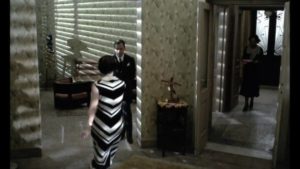
However you choose to consider Bertolucci as a director, writer and filmmaker over the duration of his remarkable career, there’s simply no escaping his killer producer-director instincts in his choice of screen material, whatever the finished results. There’s also no denying his directorial genius in casting and staffing his productions. His collaboration with Storaro of course stands in its own domain of genius. But all the genius elements in the world masterfully directed and supervised can produce perfect disasters. (Just ask Michael Cimino.) But The Conformist is a miracle of cinema. He already had Storaro; but Bertolucci got extra lucky—with art direction and production design by Ferdinando Scarfiotti, who came to him straight from Visconti; with costume design by Gitt Magrini (Antonioni) and the resources of the House of Tirelli (and its rich couture legacy); with a cast that included Trintignant, who might well have been pulled straight from Maud’s bed (as in, Rohmer’s Ma nuit chez Maud), Sandrelli, that rail-thin blast furnace of talent, Clementi, and, most miraculously, Sanda, straight from the dual endorsement of Bresson and Vogue.
But could anyone have predicted the chemistry that brought those elements together so perfectly? Sanda’s smolder, seduction, and horror; Trintignant’s ‘locked-in’ inversion of that character he took from Maud—the fractured fascist. (I think Storaro must have seen and known it as they headed towards the release date, but you can bet he appreciated that luck.) Bertolucci would get lucky again—specifically with Marlon Brando, giving the performance of his life in Last Tango In Paris. But even that great film (which Pauline Kael in The New Yorker memorably compared to Stravinsky’s Le Sacre du Printemps) does not match the perfection of The Conformist.
Departing again from Moravia finally, definitively, Bertolucci leaves his Marcello in a Rome soon to be freshly ruined, gazing, perhaps for the first time in his life, into the flames, as opposed to the shadows within which he was content to lock himself away. It’s one of the great cinematic send-offs (not unlike Persona’s final ‘rewinding’, or the violent finish to Godard’s Vivre Sa Vie). The last time I saw the film (a fresh print), my companion and I swore we could sit through another viewing immediately start-to-finish. I’m not sure I would recommend a double-viewing to everyone; but it certainly stands up to repeated viewings. Something to be recommended in these very shadowy times—even even as we look forward only to ruins—to always look to the light.

